With the Belgian First Division A recently starting its 2020/2021 campaign, it is vital that each team gets off to a bright start. Champions in recent seasons, Genk, finished in a disappointing 7th place last season. Hoping to push for the UEFA Champions League and beyond, Genk wanted to start the season with two wins in two matches. The match in question saw Genk face recently promoted OH Leuven. OH Leuven, who have the same owners as Leicester City in the EPL, are an unknown quantity for many Belgian First Division A teams, players and fans, but started their top-flight campaign with a respectable draw against KAS Eupen.
Despite the perceived quality difference between the teams, this match was not an easy match we commonly see between established and newly promoted teams in European leagues such as the Bundesliga, La Liga or other European leagues. The match finished 1-1 and while a draw was fair, the match could have gone either way, with many interesting tactical ploys from both teams. This tactical analysis will break the match down into various game moments to provide analysis and insights into the tactics utilised by each team.
Line-ups
On paper, Genk lined up in a 4-2-3-1 formation, while OH Leuven opted for a 3-5-1-1. However, both teams were rarely in such a formation, with possession sequences, offensive and defensive transitions and out of possession moments dictating how each team set up to break down the opponent or nullify attacks. Such complexities will be discussed in each relevant section.
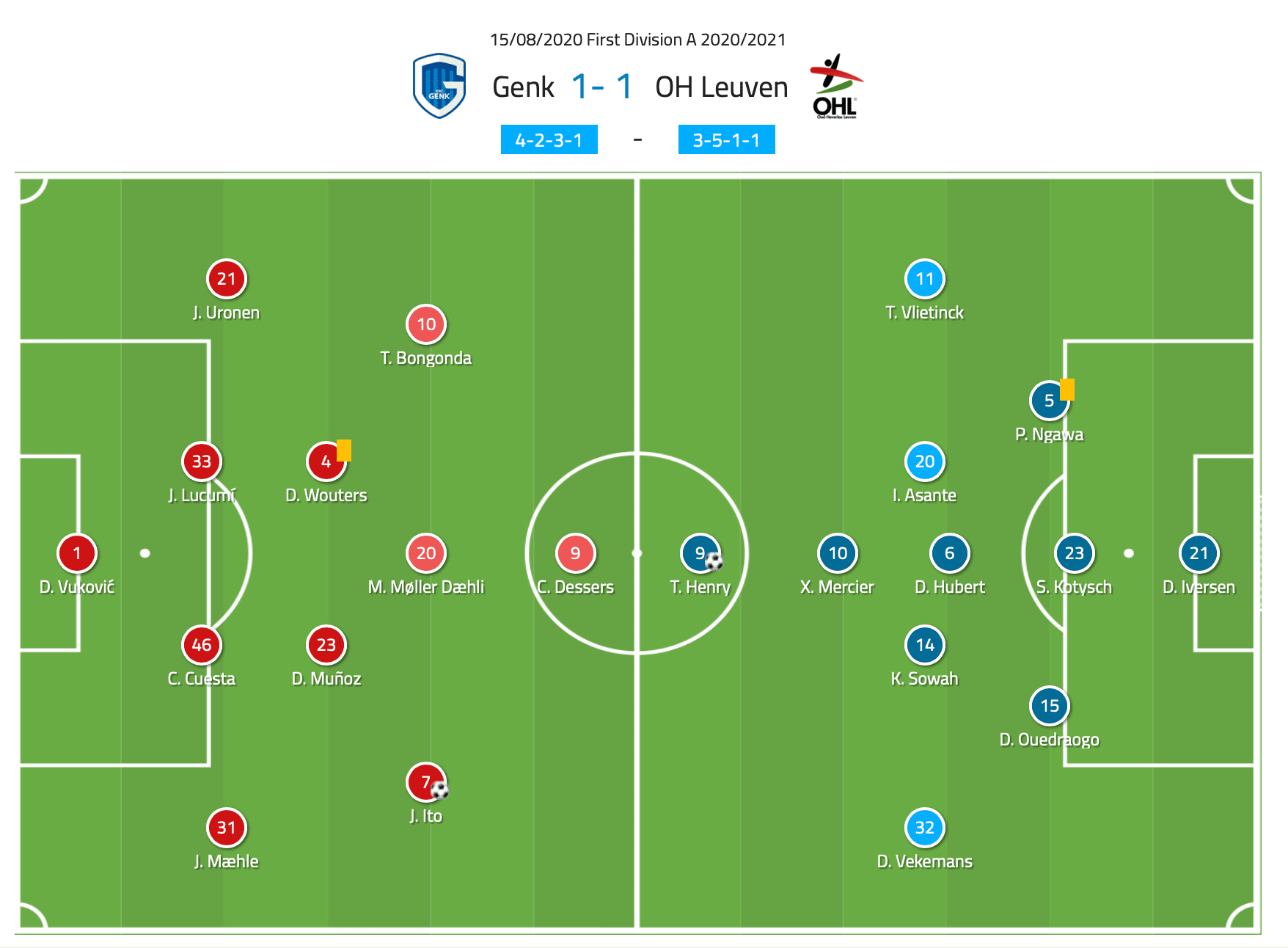
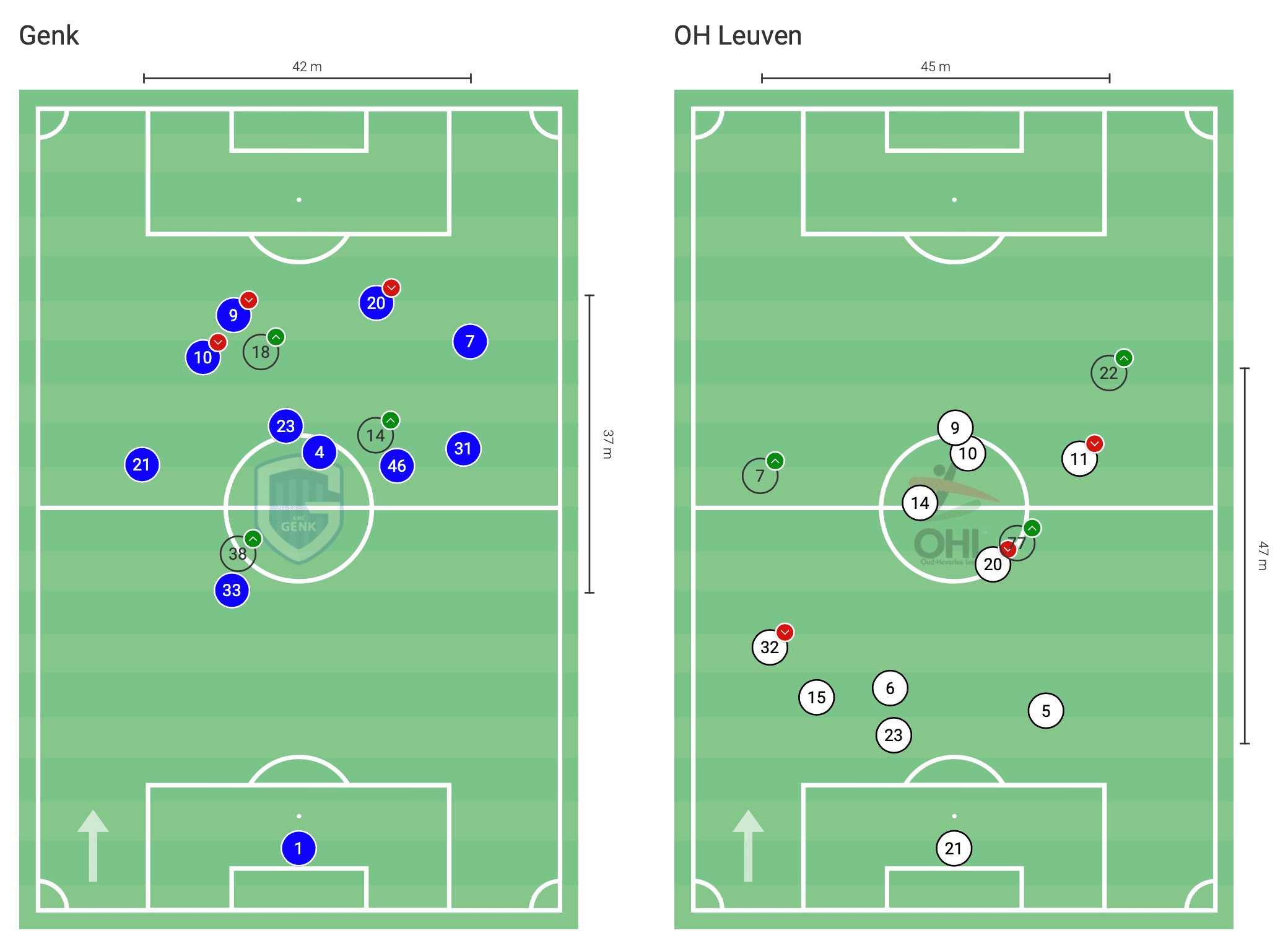
Overview
Generally, the match was played in two parts. The first part saw Genk dominating the ball, with OH Leuven happy for Genk to carry the ball with little pressure before engaging. OH Leuven played on the counter-attack, created the clearest openings in the first half and repeatedly looked dangerous by beating Genk’s initial high press when they lost the ball. While Genk had the possession and the territory, their shots were from low-quality positions in general. Genk took the lead after a wonder strike from Junya Ito, capitalising on a lack of ball engagement on the edge of the box, but again, Genk were not cutting OH Leuven’s low block open. Genk took the lead, but, Leuven had the right game plan to stay in the game, nullify big chance creation and cause problems on the break.
After the opening goal, midway through the second half, the game switched into part two. OH Leuven took up a much higher line, pressed higher and offered more options on the ball for progressive play by committing more players forward. This opened the game up, with both teams playing a similar way after OH Leuven’s main plan in part one was to stay in the game and threaten on the counter. If this was the style of the game from the offset, the quality of Genk would have likely been too much for the newly-promoted team. Instead, when they chose to switch OH Leuven threatened more from possession sequences and managed to get the equaliser. From then, both teams went for the win and in truth, the game could have gone either way.
Overall, while Genk dominated the ball for large sections of the match, OH Leuven stayed in the game, created the better chances and managed to hit back to take a point. As stated in the intro, this way not a classic high-quality team versus a newly promoted side. OH Leuven were worthy of a draw and based on total xG, they deserved to win against one of the top teams in Belgium. The game will now be broken down into each moment, with tactical annotations to highlight playing styles.

Genk dominated possession
In possession, Genk essentially played with a 2-5-3, with their full-backs pushing in into midfield and beyond. Their play was fluid and flexible, with players interchanging positions. Rather than sticking to positions, Genk were happy to rotate, as long as each position and zone on the pitch was covered. This was needed due to the low block tactics of OH Leuven until the first goal, this will be discussed shortly. Genk’s attacking players often had to play with their back to goal and drop to try to pull defenders out of position, this led to lots of layoffs or flicked balls around the corner to find free runners. A frequent tactic of Genk was to play balls down the channel between the left centre-back and left wing-back of OH Leuven, this was done via one pass if possible, or via a flicked pass around the corner from a dropping attacker. To try to stretch the opposition’s backline, Genk’s full-backs played on the edge of the touchline when in possession, attempting to pin the Leuven wing-back or wide midfielder before making overlapping runs for channel balls prior to crosses or cutbacks. Genk did have a goal disallowed in the second half after effective channel play, but the scorer was just offside.

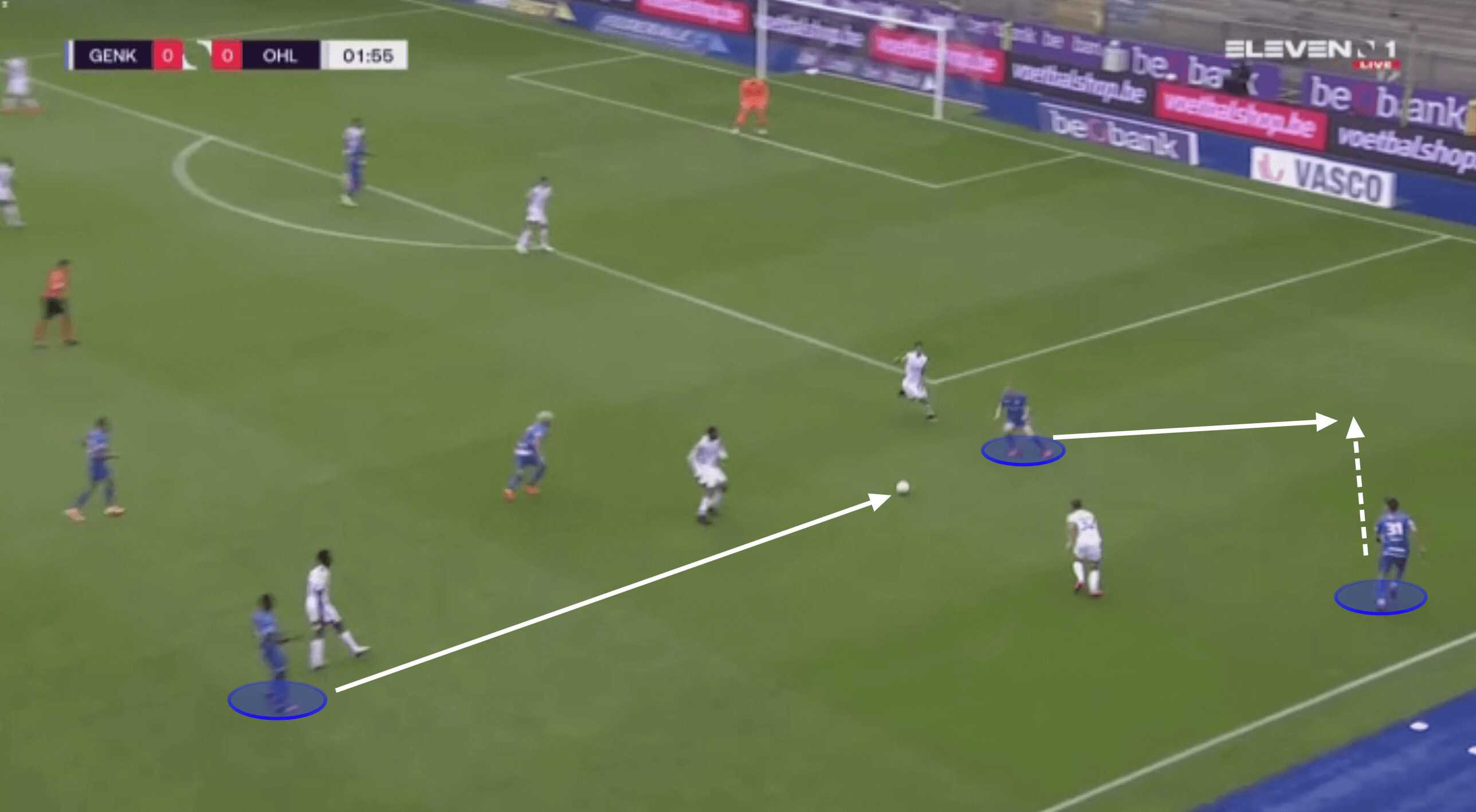
Genk created shooting opportunities but created few big chances and instead took many shots from low-quality positions, with a low xG value, or via less effective shooters. This point relates to the Genk centre-backs being happy to carry the ball way into the opposition half and up to the edge of the OH Leuven box, sometimes into the box via combination on occasion. These were half chances for Genk, but at the same time, OH Leuven were happy to concede such chances, rather than opening themselves up.
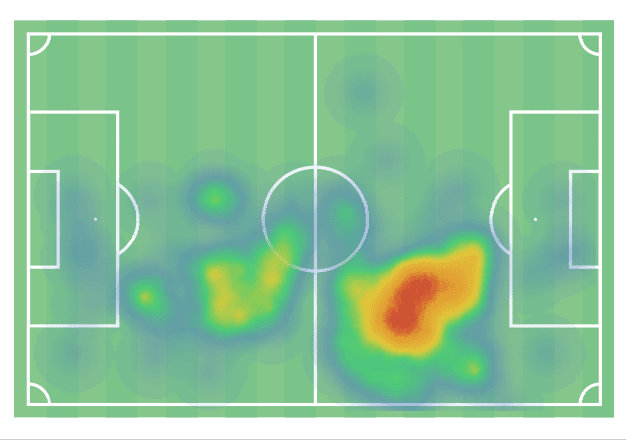
Genk maintained this playing style in possession throughout the game.
OH Leuven out of possession
Out of possession, Leuven had two systems, as indicated previously. For the majority of the match, when the game was 0-0 and shortly after Genk took the lead, Leuven dropped off Genk. The drop off consisted of a mid-block at it’s highest and a drop to a low-block quickly. From there Leuven did not engage the player with the ball and only pressed to block passes once the ball carrier had travelled past the edge of the centre circle in OH Leuven’s half. The shape was frequently a 5-4-1 or a 5-2-2-1. As stated, OH Leuven man-marked, rather than pressing the ball. This worked for them as they were tough to break down and often the ball carrier, usually a centre-back, only had options to the side, rather than being able to penetrate. If Genk did work a shooting opportunity then it was usually from outside the box, with multiple bodies between the player and the goal, including the goalkeeper. To add, the shooter was normally a defender or more defensive midfielder, rather than the most potent Genk players.
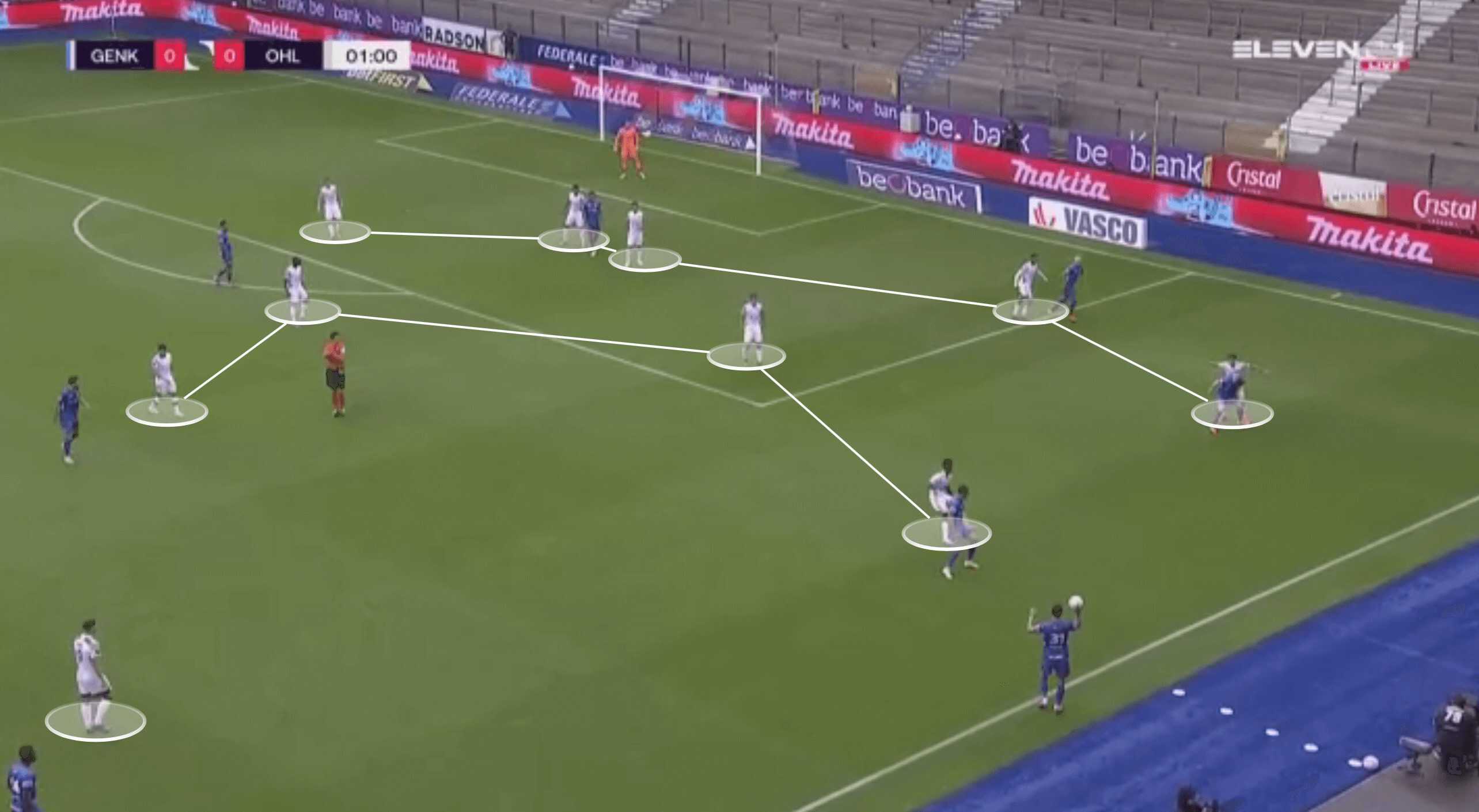
OH Leuven had some risky moments and rode their luck somewhat with this strategy but it appeared to be optimal to stay in the game, it also gave them opportunities for swift counter-attacks with Genk very high and wide. The key occasion where the strategy let them down was for the goal. Ito carried the ball from out wide into a central area on the edge of the box. Whilst not pressing the ball had worked for Leuven, a player needed to step out and engage to block the shot, but the mentality of sitting off and a lack of communication led Ito to have a free shot. Ito still had a lot to do, the shot had an xG of 0.05, but with his quality, he found the top corner with a curling left-footed shot.
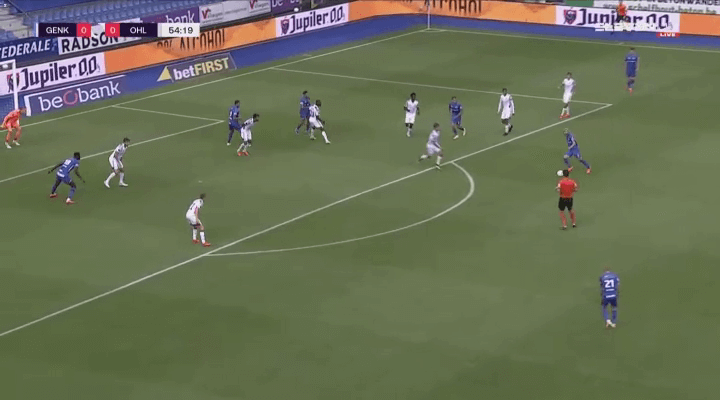
After the goal, OH Leuven went from sitting off in a low block to pressing in an initial mid to high block without the ball. The defensive line reached the edge of the centre circle in their half, rather than sticking close to the edge of their defensive box. They dropped as Genk progressed, but they were more active in attempting to regain possession to then build quick or progressive attacks themselves.
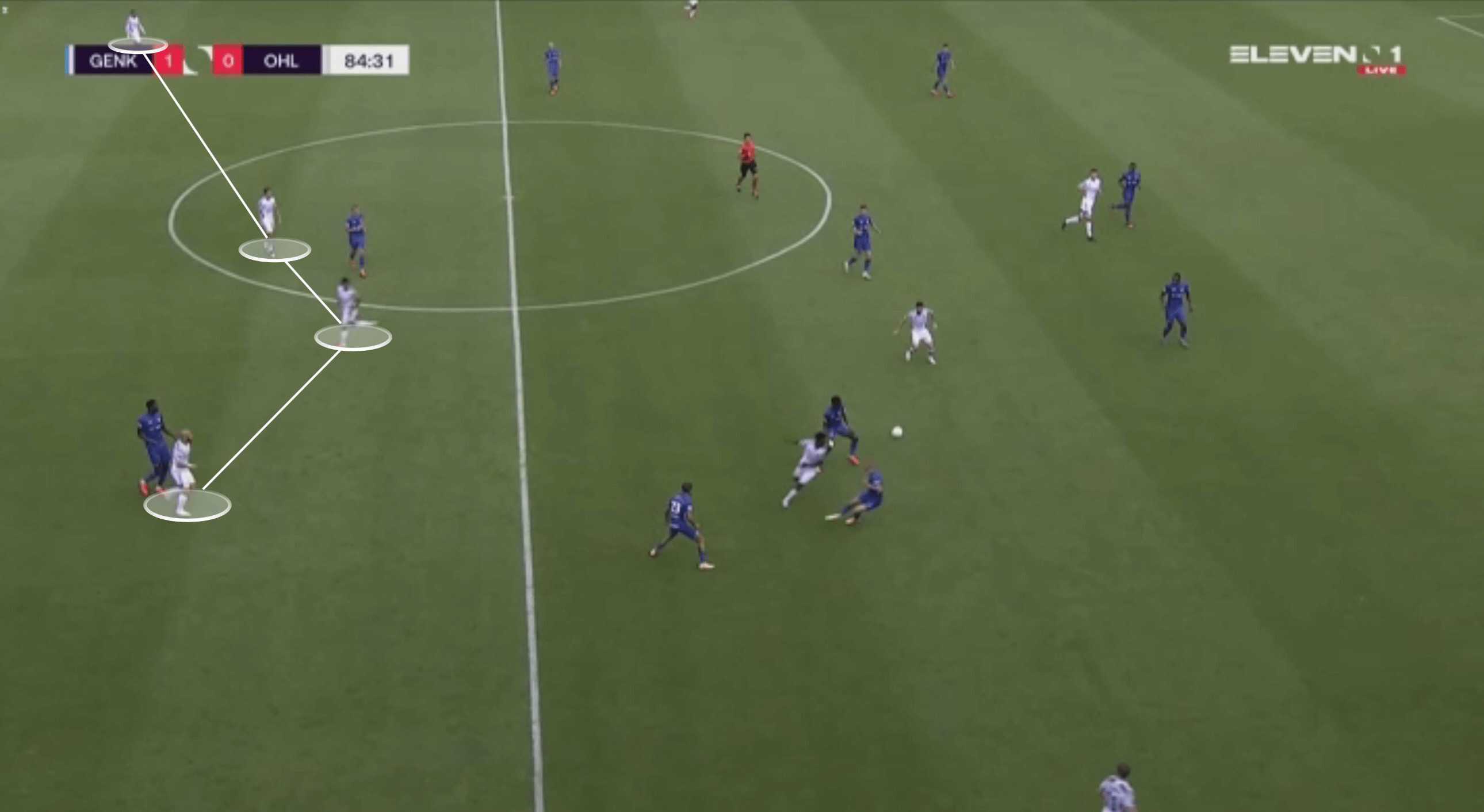
OH Leuven countered with pace
Throughout the match, but particularly when Leuven sat back and let Genk push forward, Leuven hit Genk with swift counters in attacking transitions. The counters were effective in creating numerous shooting opportunities and big chances for Leuven. In the first half, these counters created big changes with xG values of 0.36 and 0.50. To add more context, Genk did not have a big chance in xG terms until the 2nd half and the match finished with Genk having two big chances and OH Leuven having three. For those unaware, a big chance is thought to be a shot with an xG of 0.30 or more.
The counters were effective because they exploited the space after Genk had pushed up, but the counters were also risk-free, as Leuven could commit three to four players to a counter-attack, and create an overload with those numbers, meaning the Leuven defence could have a break and maintain their solid shape.
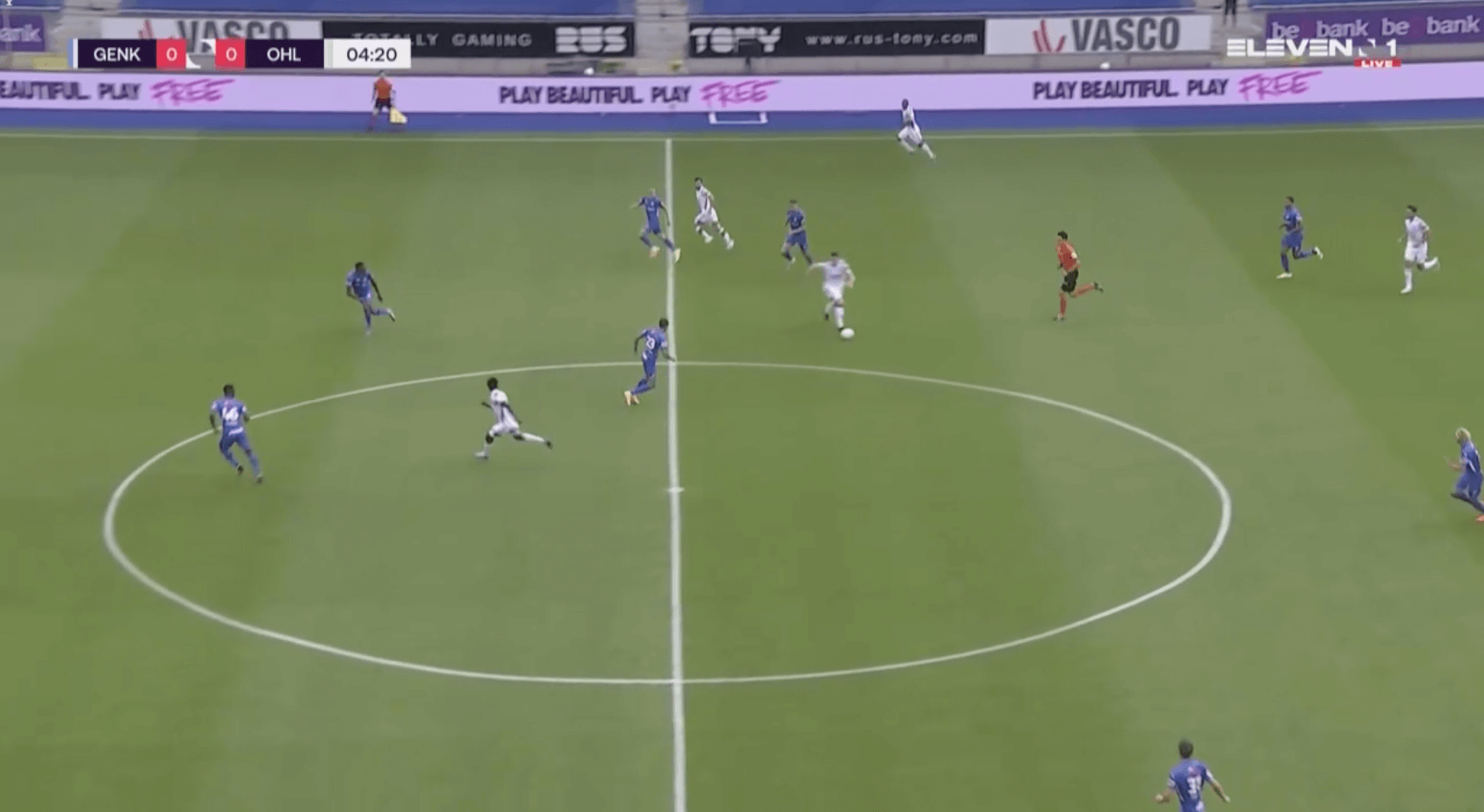
After Genk scored, OH Leuven countered less, but this was due to a change in strategy, with higher positioning, more pressing and more possession sequences, rather than waiting for Genk to progress before countering.
Genk in defensive transition
Given Genk had 64% possession, they controlled the majority of the game. However, given we know that OH Leuven looked to counter quickly, Genk employed a counter-press to win the ball high, given their positioning was high and they knew there was space for the opposition to exploit if they were allowed time and space to pick passes. Genk, therefore, tried to win the ball back quickly. If they were unable to, then committed recovery runs were needed from the defenders. The majority of the time, the Genk midfield and attackers were slow to recover, highlighting Genk’s preference to attack and leave men forward. Leuven had high-quality chances on the counter and Genk were lucky not to be at least a goal behind in the first half. This is based on opinion but reinforced by xG again.
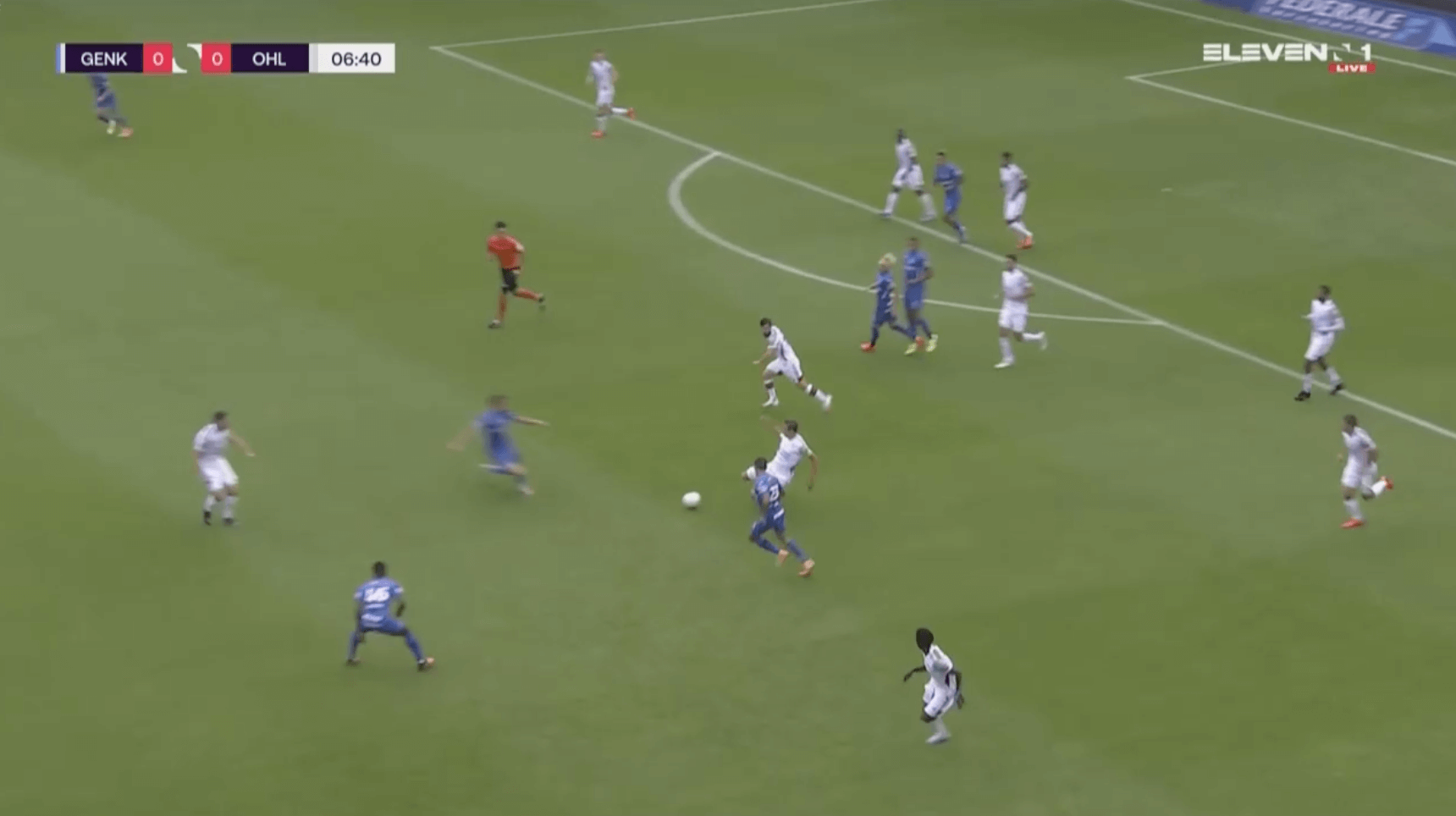
When OH Leuven had the ball
We know that Leuven looked to counter until they went behind, though prior to this and afterwards, they did have possession sequences. A common tactic before OH Leuven went behind was for the GK to pass to the left centre-back, that player would then look for a long ball to Thomas Henry. The tall striker could then look to knock it down to nearby players.
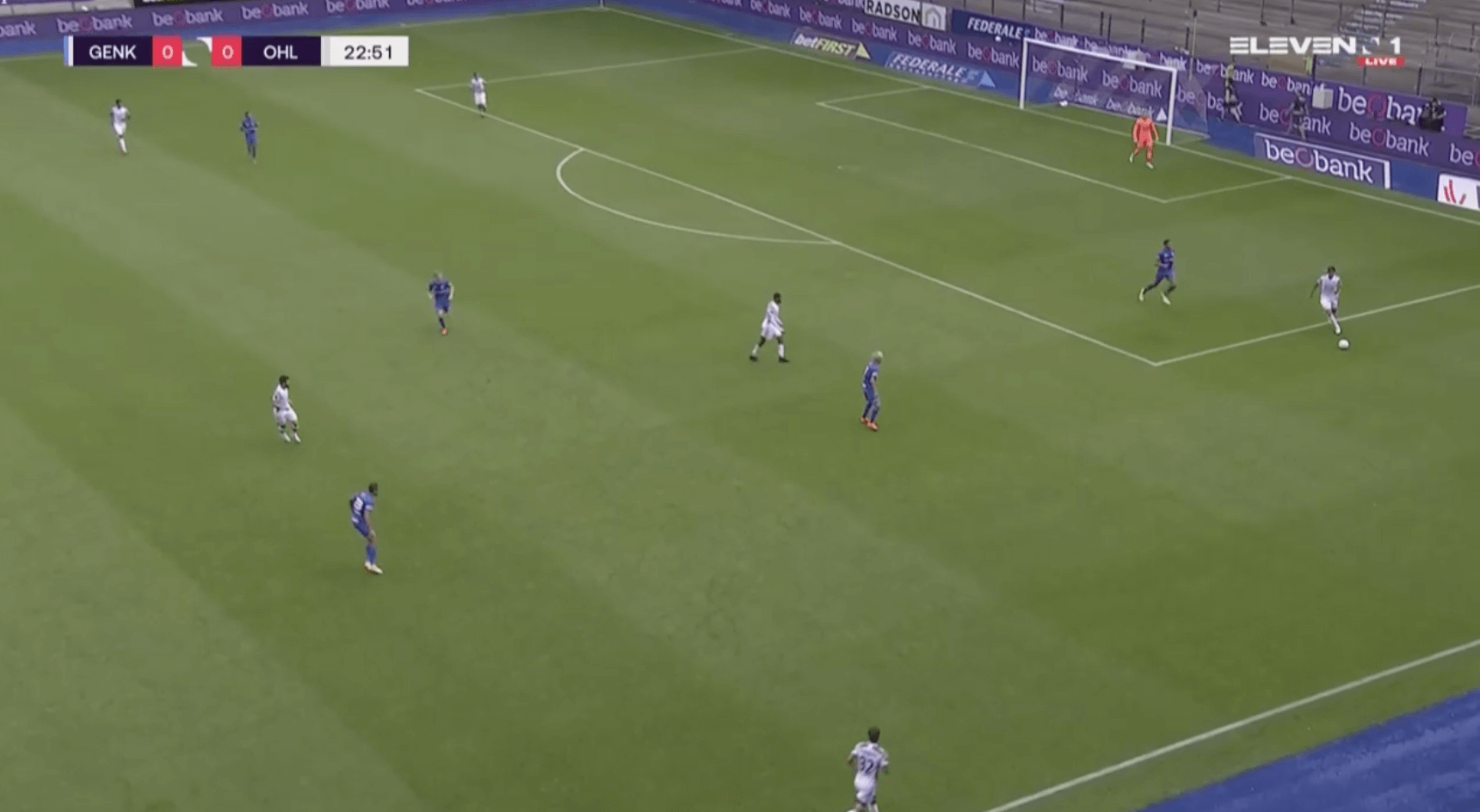
This tactic carried on throughout the match, but after going behind, OH Leuven decided to play more, commit more bodies forward and try to build attacks. They created their goal from a slower attack, but the counter or direct play to Henry was also effective throughout. This praises the newly promoted side as they were able to defend well and create via numerous strategies against a top team in the league.
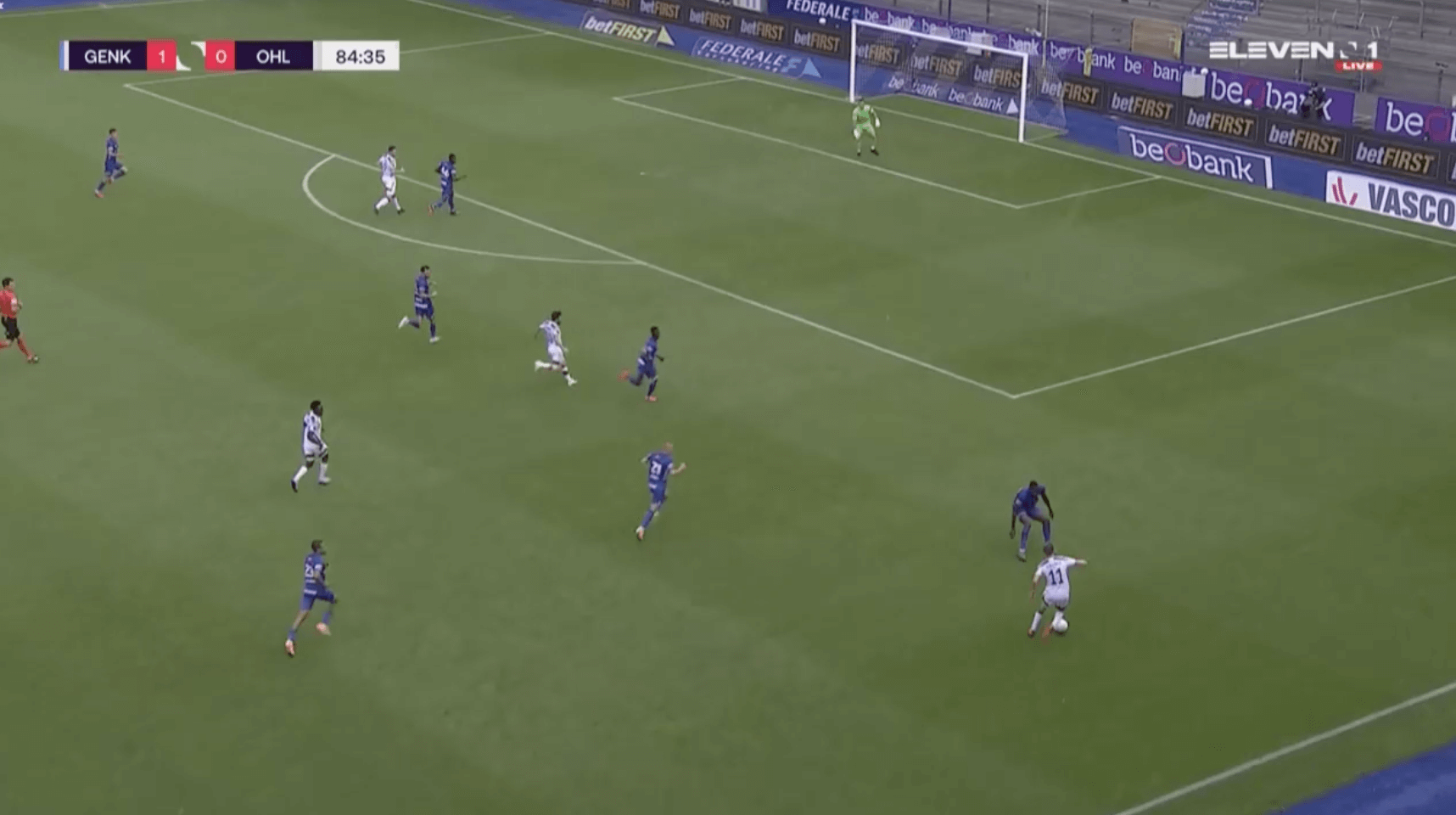
Genk without the ball
When out of possession Genk, if facing a counter, Genk transitioned quickly to win the ball back quickly and nullify the counter. When out of possession for a settled attack, Genk dropped towards the edge of their own area. This was typically after they had taken the lead. However, whilst OH Leuven defended out of possession with the whole team, Genk were slower to drop and instead left offensive players ahead of the ball in numerous situations, at 1-0 this was done to try and counter and then kill the game and at 1-1 Genk wanted to try and regain a lead.
OH Leuven in defensive transition
The majority of these points have been discussed in other game moments. But, when operating conservatively, Leuven used the defensive transition to drop into shape, rather than press. The players did not engage the ball and man marked to block against penetration.
When OH Leuven went behind, they were much more proactive in their defensive transition, their first thought was to try and win the ball back, knowing they had to show more urgency and had space in behind their defence and gaps that could be exploited if they didn’t press Genk to win the ball or at least slow the play so Leuven could retreat.
Conclusion
This was a really entertaining game, with interesting tactical ploys from both teams. In the match, we learned more about OH Leuven than Genk, given our knowledge of Genk as one of the top teams in Belgium, and a lack of knowledge on newly-promoted Leuven. Genk dominated possession but struggled to create clear chances against a stubborn OH Leuven defence. Genk took the lead but were pegged back and in truth could have found themselves behind after effective OH Leuven counters. OH Leuven struck back after converting to a progressive style. But, the main takeaway is the OH Leuven have the capabilities to adapt to the team they are facing and cannot be written off in the top division, given they provided defensive solidity and offensive creation via numerous strategies against a team who have recently won the league. Both teams are unbeaten in the new season and will look to learn from this match to build future performances.






Comments